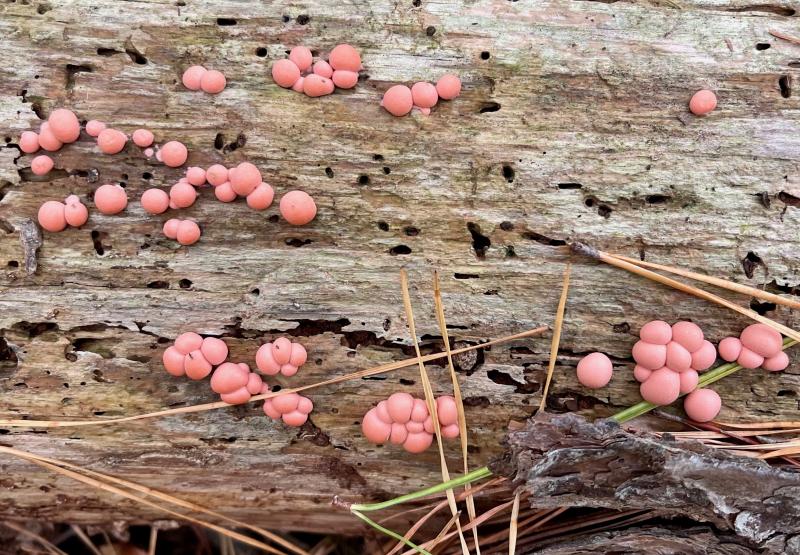Anything more Christmassy than slime mold and sassafras?
The professor and I hiked through the piney dunes of Cape Henlopen State Park on a bright fall day back in November.
With cameras in hand to photograph interesting images, and conversation fueled by the oxygen-rich forest, the 90-minute hike passed quickly. But not before we stopped to admire autumn’s golden leaves in a small grove of sassafras trees, and Braille-like pinkish mushrooms growing in random formation on a decaying fallen log.
I told the professor I could get a column out of those mushrooms. The grove of sassafras offered an added bonus.
As it turns out, based on internet research from a variety of sources, the pink mushrooms were not mushrooms at all, but rather a species of slime mold known as Lycogala epidendrum (possibly terrestra). The pretty little cushions secrete a pinkish, milky substance at one point in their life cycle which has given them a couple of common names, including wolf’s milk and toothpaste slime. As appetizing as both of those names may be, depending on your own particular species, this version of slime mold, which feeds on bacteria and fungal spores, is not considered edible.
That means feast on it only with your eyes.
But there is a Christmas connection.
Many children will receive gifts of another version of slime this year in their stockings or under their trees. Slime, which pretty much looks like and feels like colorful slime, has been popular among children since about 2015. It’s a tactile thing, not dissimilar to the gifts of silly putty received in their distinctive, plastic, egg-like packages 40 and 50 years ago.
The latest iteration of slime, however, is much slimier. Kids like to feel it in their fingers, pull and shape it in all kinds of directions and then delight in the unique, slime-popping noise made when they pull out their fingers stuck in the substance. Some say the sensation is as organic and satisfying as popping bubble wrap.
Slime molds, though, have captivated people’s imagination for much longer. In 1958, the horror movie titled “The Blob” was loosely based on an evil version of slime mold. Not the innocent and pretty wolf’s milk slime mold, but something far more sinister and creepy. Don’t forget to check under your bed tonight.
The commercial version of slime produced by a variety of vendors often involves a simple recipe of glue, borax, food coloring and a variety of other flashy ingredients like glitter. If you want to make some of your own, check out slime recipes on the web.
Run, don’t walk!
As for sassafras, a Christmas connection is there as well. This nicely shaped, randomly branched tree with leaves of three different shapes – including mittens – likes the well-drained soils of our coastal woods. The fragrant bark of its roots provided the original distinctive flavor for root beer.
Dating back to the mid-1850s, Pennsylvania Dutch farm wives would make their own version of Christmas trees using three- and four-foot sassafras trees cut out of hedgerows alongside fields. Get rid of a nuisance, create a decoration.
The trees would be propped up in a pail of heavy dirt. Using thin strips of white cotton, women would wrap each branch of the small tree to give it the effect of a coating of snow. Then the branches would be hung with natural ornaments such as small red apples or strings of cranberries. The snow-covered sassafras trees made for a distinctive holiday tradition.
Then as now, however, slime wasn't considered one of the favored tree ornaments.























































